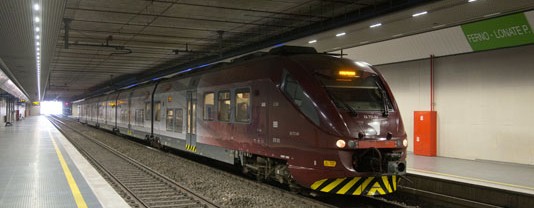Our appointment is in the new Ferno-Lonate railway station, on the Ferrovienord line that runs from Busto Arsizio to Milan-Malpensa Airport. Our guide on this visit to the first substation in Europe able to recover the electricity produced by trains powered at 3000 V cc while braking and use it for electrical services in the station itself is Mr. Marco Barra Caracciolo, engineer and the company’s managing director, accompanied by a small group of technicians.
This cutting-edge application is going to have extremely important effects on future power management. Energy needs to be consumed intelligently and this system, which makes it possible to recover the huge amount of energy generated by braking trains is a prime example, one that is accompanied by a package of additional actions that Ferrovienord has already begun or is about to implement. The substation is just a few kilometres from Ferno-Lonate, a station built underground. We reach it in a hybrid car (with a thermal electric engine), confirming that actions to consume energy intelligently come in all kinds of forms. From outside, the building is identical to others of the same size (3.6 MW) but since May 2012 it has become an honest-to-goodness laboratory for testing this new installation “live”.
Mr. Barra Caracciolo, the satisfaction of you and your collaborators with this substation is obvious, and completely justified. There aren’t any like it, not just in Italy but not even in Europe and probably the entire world. And above all, it works. An idea that’s a winner. Tell us about how you got to this point and where you started out from.
Before going into the details I’d like to briefly run through the main characteristics of our network, which has an extension of about 320 km. It’s small compared to the national total, which is around 16,000 km, but it’s complex because we have everything. We have the “Brescia branch,” which is the line that goes from Brescia to Edolo, in the Alps, with diesel traction and single track, but also the “Milan branch” where the network is totally electrified at 3000V direct current, plus around Milan we have lines not just with double track but even quadruple track, like in the section from Milan to Saronno. The network is interconnected with RFI, the Italian Rail Network, and is interoperable. To give you an example, thanks to the connecting line built to Busto Arsizio, the Swiss TILO electric trains coming down from Ticino have an easy journey to Malpensa airport. Getting back to interconnections, the main one is at Milano Bovisa, with the “Passante” through line that enables trains to reach Milano Centrale via Milano Garibaldi. It’s thanks to these interconnections that the Malpensa Express trains connect Milano Centrale with Malpensa international airport.
Franco Tanel
Full article is available only for registered users.
Click the link below to download pdf version of Railway Engineering
